Discover Top 7 Scariest Staircases To Climb In The World
Nature is full of wonderful and beautiful sites that people have not yet discovered, and natural staircases are always interesting choices for hikers and adventurers who want to challenge themselves. There are hundreds of thousands of staircases around the world that are dangerous, but they are also considered the most favorite tourist destinations.
There is something provocative about staircases that can actually enhance the beauty and mystery of a site. Maybe it’s because they are so often more roughly hewn from stone or wood, or maybe it’s the simple feeling of ascension—whatever the deal is, steps that have been installed out in nature (man-made or even naturally occurring) can create some damn stunning scenery, according to Atlas Obscura.
Here are some of the scariest and best staircases to climb in the world.
1. Mount Huashan Heavenly Stairs, China
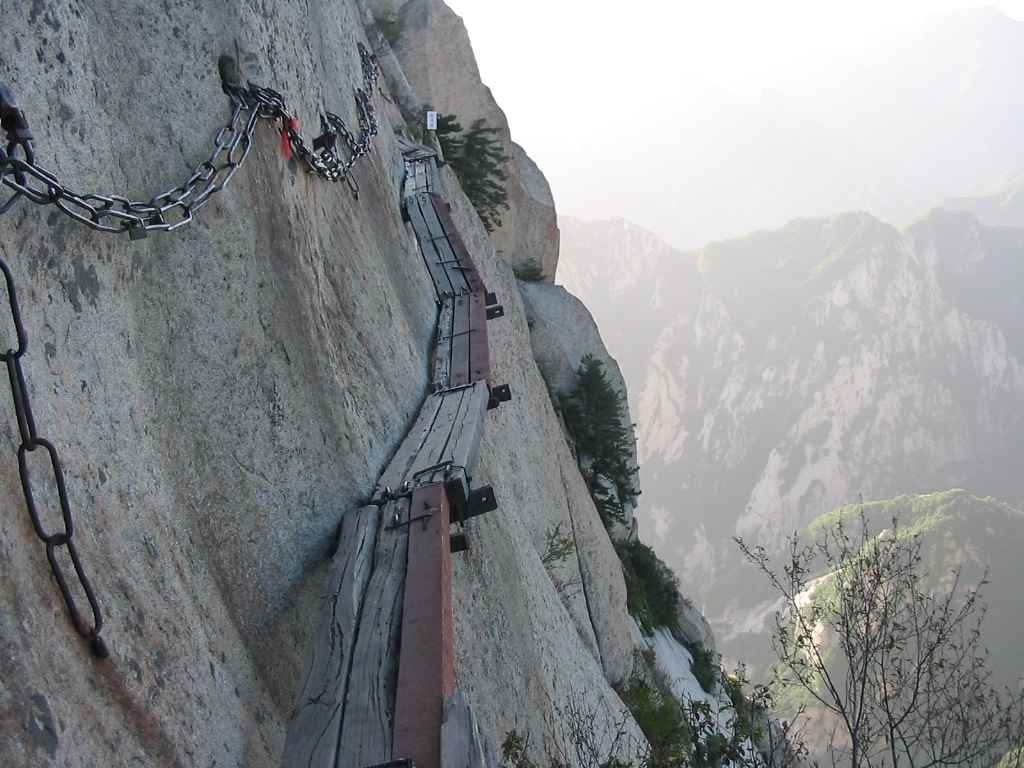 |
| Photo: Unusual Places |
Mount Huashan is located in Huayin, part of the Shaanxi province. The closest city, Xi’an, is 120 kilometers away. The teahouse of the top of the mountain is located on the south side of the mountain, at an altitude of 2,160 meters. Viewed on a map the Huashan mountain chain looks like a flower.
The teahouse at the top of the mountain is actually one of the many Taoist temples located on the five peaks that make up the Huashan Mountain. Given that the first inhabitants of this region practiced asceticism their daily meditation was accompanied by a cup of tea. Thus, after decades the temple became a tearoom that’s visited annually by thousands of tourists.
The road to the mountain top starts with a lot of huge stairs, nicknamed “The Heavenly Stairs”. The first impression is that the stairs lead to heaven, it’s like climbing towards the clouds and it’s impossible to see where the stairs end. On your way to the top, you’ll see houses and even small villages. However, the road does not stop here. After passing the stairs a gondola will take you to the teahouse, according to Unusual Places.
The side stone steps are supported by a single railing in which many trekkers hang on to as they ascend up. Unfortunately, if you thought these steps were the most dangerous part, you would be wrong. What awaits climbers after these steps is a trail known as the most dangerous on earth, a horizontal walkway consisting of planks fastened to the side of the mountain with just a single chain.
2. Haiku Stairs, Oahu, Hawaii
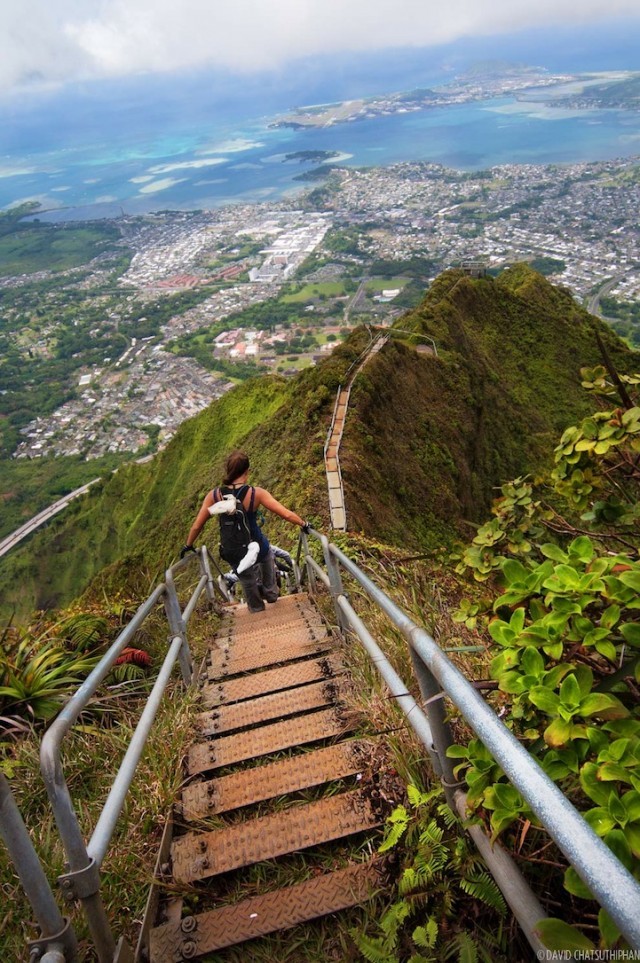 |
| Photo: Wikipedia |
The Haʻikū Stairs, also known as the Stairway to Heaven or Haʻikū Ladder, is a steep, steel step structure that provided pedestrian access to former U.S. Navy communication facilities on the island of Oʻahu, Hawaii. The more than 3,000 steps span along with Oahu's Ko'olau mountain range. The pathway has been used as a hiking trail at various times but is not open to the public. The city council voted to remove the stairs in 2021.
In 1942, contractors for the U.S. Navy began construction of the Haʻikū Radio Station, a top secret facility that was to be used to transmit radio signals to Navy ships that were then operating throughout the Pacific. In order to obtain the necessary height for the antennae, the Navy stretched them across Haʻikū Valley, a natural amphitheater. Some remnant parts of the wooden ladder may still be seen beside the metal steps.
The radio station was commissioned in 1943. To transmit such a powerful signal, the Navy needed a transmitter of greater capability than possible with vacuum tube technology at the time. They, therefore, decided upon an Alexanderson alternator, a huge device capable of generating powerful low-frequency radio signals, and requiring a large antenna.
When the Naval Air Station Kaneohe Bay was transferred to the Marine Corps as Marine Corps Air Station Kaneohe Bay in the 1950s, the U.S. Coast Guard used the Haiku Radio Station site for an Omega Navigation System station. In the mid-1950s, the wooden stairs were replaced by sections of metal steps and ramps — by one count, 3,922 steps. The Coast Guard allowed access in the 1970s but stopped after an appearance on Magnum, P.I. increased visitation. The station and trail were closed to the public in 1987.
3. Pailon del Diablo Waterfall, Ecuador
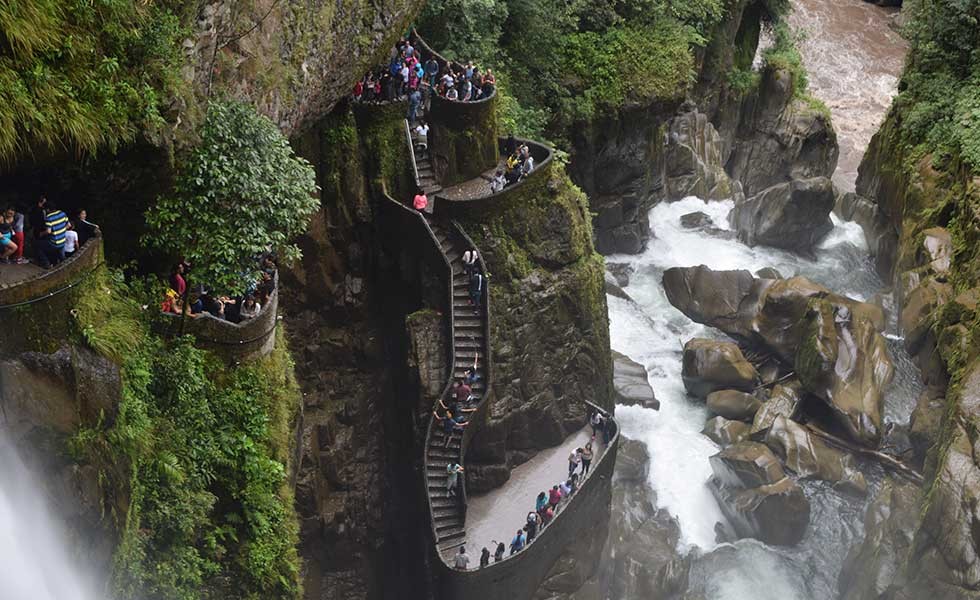 |
| Photo: Bucket List Ecuador Travel |
The Pailon del Diablo, or Devil's Cauldron, is an aptly-named waterfall on the Rio Pastaza, a tributary of the upper Amazon River Basin. The trail begins in a small village called Rio Verde, located about 30 minutes from the recreational haven of Baños. The trailhead for this hike is conveniently located at the end of the Ruta de las Cascadas, a popular bicycling route that begins in Baños and follows a series of impressive cascades for roughly 17 kilometers to Rio Verde, ending at the most spectacular waterfall of the route, the Pailon del Diablo.
This is a relatively easy hike down to the waterfall and back, but visitors should allow a few hours to soak in both the waterfall itself, as well as the immense hydrologic power churning through the gorge in this portion of the Rio Pastaza. After descending into the gorge from town, the well-marked trail winds toward the entrance, where for a small fee visitors are allowed access to an otherworldly set of stairs carved out of the cliffs adjacent to the waterfall. For those willing to get wet, a small cave-like trail follows the cliffs uphill through a series of narrow openings for a closer view of the falls, according to The Outbound.
4. Half Dome Stairs, California, USA
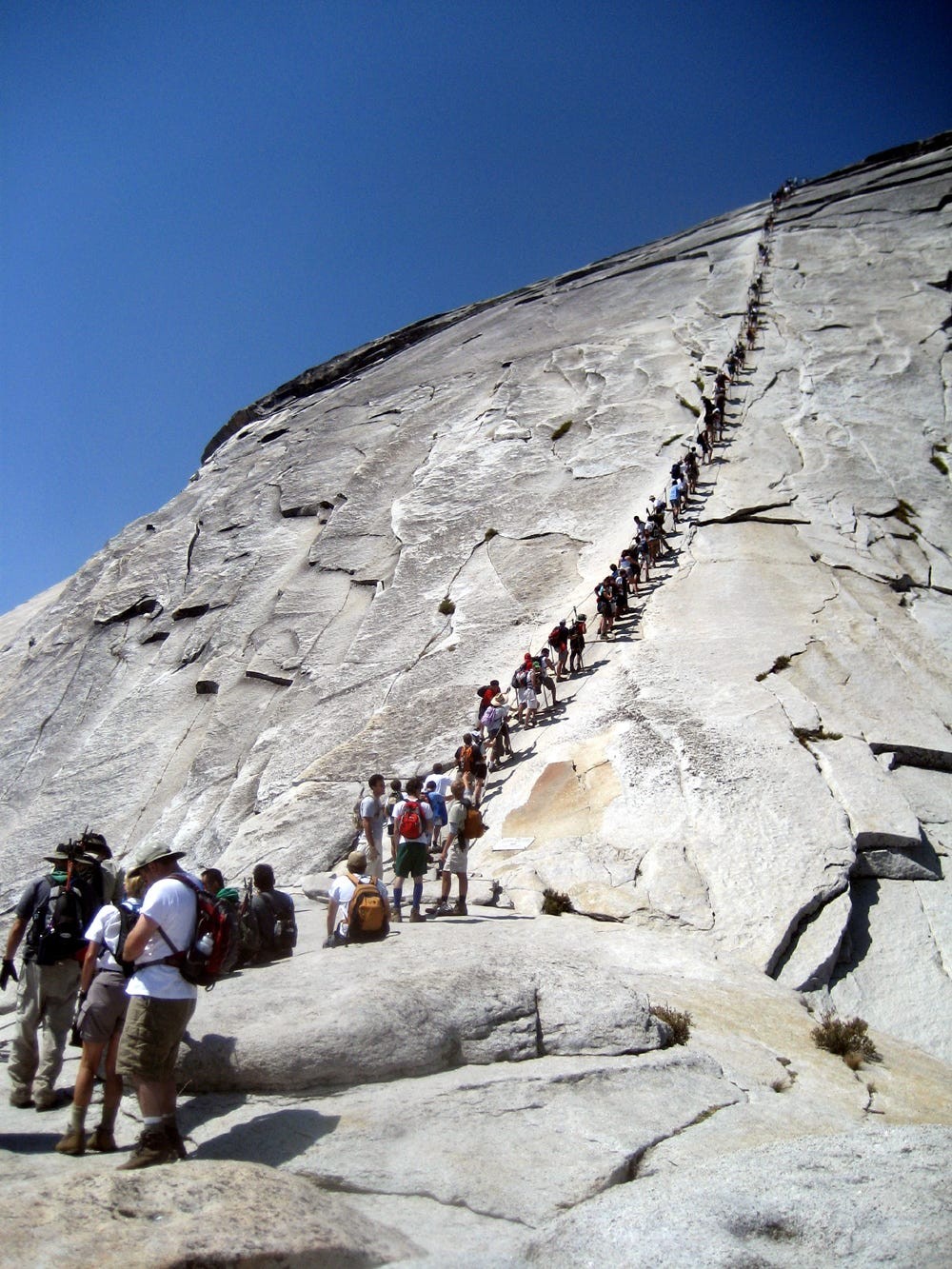 |
| Photo: Business Insider |
Rising nearly 5,000 feet above Yosemite Valley and 8,800 feet above sea level, Half Dome is a Yosemite icon and a great challenge to many hikers. Despite an 1865 report declaring that it was "perfectly inaccessible, being probably the only one of the prominent points about the Yosemite which never has been, and never will be, trodden by human foot," George Anderson reached the summit in 1875, in the process laying the predecessor to today's cable route.
Today, thousands of people reach the summit. For most, it is an exciting, arduous hike; for a few, it becomes more of an adventure than they wanted. Indeed, park rangers assist hundreds of people on the Half Dome trail every summer. Most of these emergencies could have been prevented... read on to learn how.
The 14- to 16-mile round-trip hike to Half Dome is not for you if you're out of shape or unprepared. You will be gaining elevation (for a total of 4,800 feet) most of your way to the top of Half Dome. Most would say the reward is worth the effort. Along the way, you'll see outstanding views of Vernal and Nevada Falls, Liberty Cap, Half Dome, and--from the shoulder and summit--panoramic views of Yosemite Valley and the High Sierra.
Most hikers take 10 to 12 hours to hike to Half Dome and back; some take longer. If you plan on hiking during the day, it's smart to leave around sunrise (or earlier) and then have a non-negotiable turn-around time. For instance, if you haven't reached the top of Half Dome by 3:30 pm, you will turn around. Check for sunrise and sunset times before you hike. Regardless, each person should carry a flashlight or headlamp with good batteries (hikers commonly struggle down the trail after dark because they don't have a flashlight). Although the trail is well marked, you should be prepared with a good topographic map and compass and know how to use them, according to National Park Service.
5. Catacombs, Paris
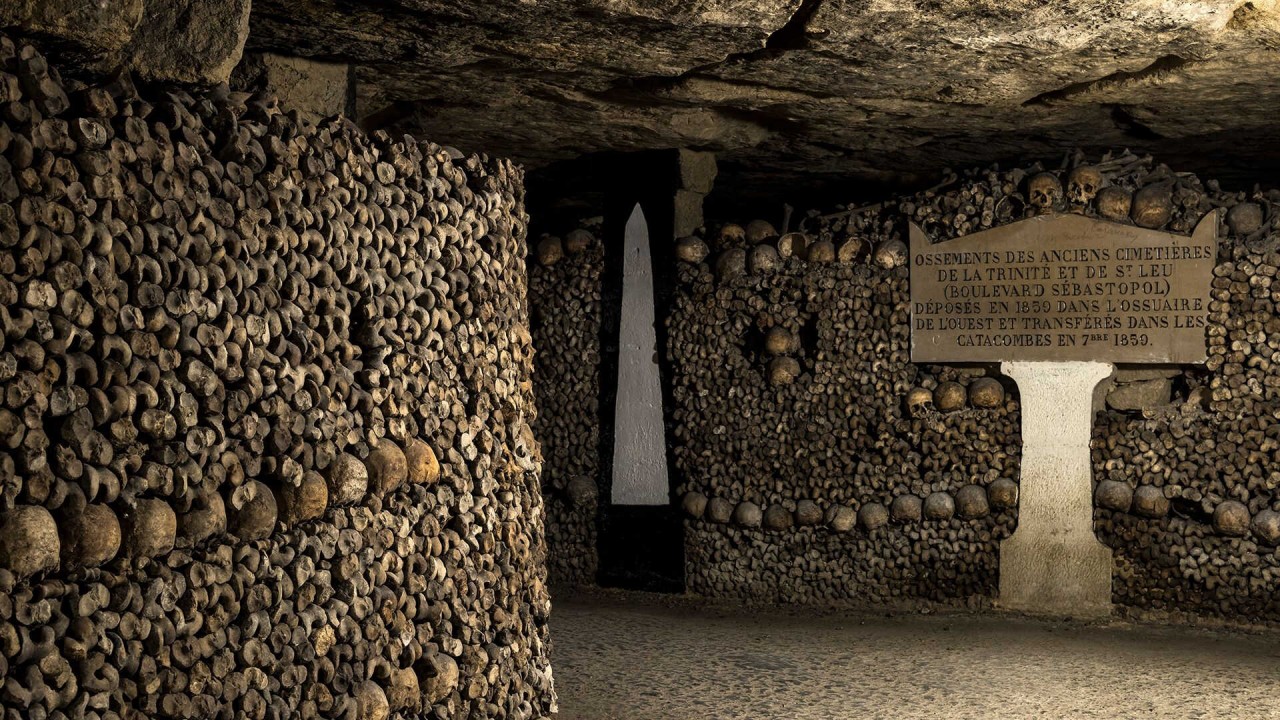 |
| Photo: Catacombes de Paris |
The Catacombs of Paris (French: Catacombes de Paris, About this soundpronunciation (help•info)) are underground ossuaries in Paris, France, which hold the remains of more than six million people[2] in a small part of a tunnel network built to consolidate Paris' ancient stone quarries. Extending south from the Barrière d'Enfer ("Gate of Hell") former city gate, this ossuary was created as part of the effort to eliminate the city's overflowing cemeteries. Preparation work began shortly after a 1774 series of gruesome Saint Innocents-cemetery-quarter basement wall collapses added a sense of urgency to the cemetery-eliminating measure, and from 1786, nightly processions of covered wagons transferred remain from most of Paris' cemeteries to a mine shaft opened near the Rue de la Tombe-Issoire.
The ossuary remained largely forgotten until it became a novelty place for concerts and other private events in the early 19th century; after further renovations and the construction of accesses around Place Denfert-Rochereau, it was opened to public visitation from 1874. Since 2013, the Catacombs number among the fourteen City of Paris Museums managed by Paris Musées. Although the ossuary comprises only a small section of the underground "carrières de Paris" ("quarries of Paris"), Parisians currently often refer to the entire tunnel network as the catacombs.
6. Flørli Stairs, Norway
 |
| Photo: Outdoorlife Norway |
The Flørli stairs have 4.444 steps and is one of the longest wooden staircases in the world. The staircase follows the watergates supplying the hydropower station at the quay. The stairs end at the Ternevass dam. Well above the treeline, you will enjoy the great view out of the Lysefjord and toward the Preikestolen massive from up there.
If you want to catch all the 4444 steps, but do not want a long trip, you can follow a 100-year-old trail from the top down to Flørli again. The trail was originally used by navvies da dam at Tern Lake would be built. Here were transported machinery and equipment that would be used in the construction process. The dam was begun in 1918 and the entire facility was completed in 1920.
From the weir western side of the trail starts. On top, you'll find a solid beacon showing the way. Down the path, you will see several large boulders that are set up as wizards. The trail goes for a while on the bare mountain, before one must cross a scree. After scree, you reach down to the vegetation and cross the service road. Moreover, the path must cross Flørliåa the bridge.
From here, take the main trail that goes down to Flørli. Crosses a tributary of Flørliåa suspension bridge. It is worthwhile to stop and look around at Flørli Stølen. Back on the quay is the summer open Flørli gallery and café in the historic hydropower station - enjoy a well-deserved snack here, according to Visit Norway.
7. Sagrada Familia, Spain
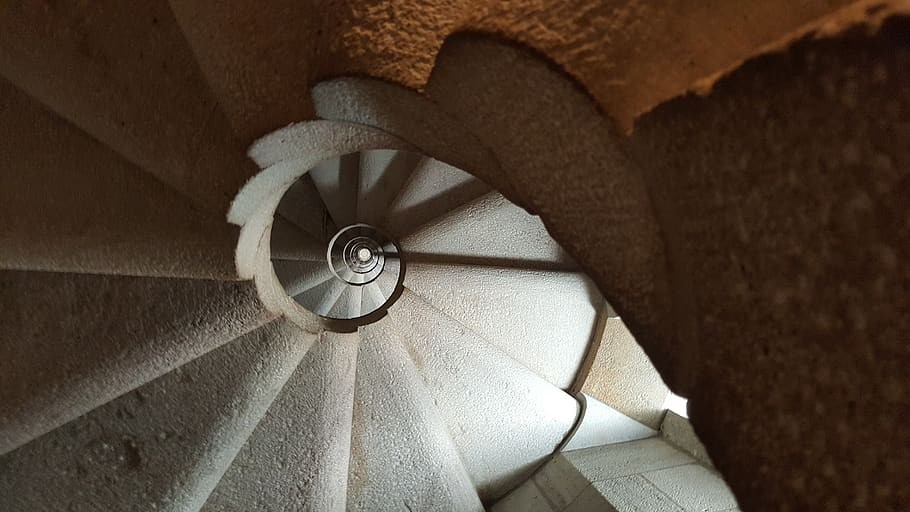 |
| Photo: Wallpaper Flare |
La Sagrada Familia is an absolutely breathtaking church located in Barcelona, Spain. The architect behind this gem, which is still not completed, is none other than Antoni Gaudí. Gaudí has world-renowned masterpieces spread throughout Barcelona, although none have quite an interesting background like La Sagrada Familia.
Construction for the Sagrada Familia project began in 1882. When Gaudí died in 1926, only a quarter of the basilica was completed. Although Gaudí made sure to spend his last few years dedicated to the project, it was clear that it wouldn’t be finished during his lifetime. This year, it’s believed to have entered its final stage of construction, with 2026 as its estimated completion date.
While 150 years is certainly a long time to build something, think about this: when La Sagrada Familia is completed, it will have taken longer to build than the Egyptian Pyramids, and only 50 years less than the Great Wall of China. That’s pretty amazing.
During the early days of La Sagrada Familia’s construction, Gaudí built a school on the site called the Sagrada Familia Schools building. The school was built for the children of construction workers to attend while their fathers spent their days and nights building one of the most magnificent structures in all of Europe. Designed in 1909, the school is now the site of an exhibition on the Sagrada Familia. Gaudí seems to have been a very thoughtful man.
Though a long ways from being completed, La Sagrada Familia was designated as a UNESCO World Heritage Site in 1984. It received the designation mostly because of its unique architecture and Gaudí’s ability to create something so innovative and artistic. This is not a surprise, however; La Sagrada Familia is one of seven buildings by Gaudí that fall under this category, according to Culture Trip.
 | Vist These Most Beautiful And Snowiest Cities In Europe Winter is the perfect time for a break away from the busy life, and these snowy cities around Europe are wonderful choices for a post-Christmas ... |
 | The Best WWE Wrestlers In The World WWE has been a famous sport around the world, and these wrestlers have made a great name for themselves, including John Cena, The Rock, Seth ... |
 | The Best Games Like Minecraft That You Can Play If you love building games, blocks, and houses like Minecraft, these great alternatives can be great choices for you to play and discover a new ... |
Recommended
 Travel
Travel
Vietnam Through Australian Eyes: Land of Flavor, Warmth, and Timeless Charm
 Travel
Travel
Strategies for Sustainable Growth of Vietnam’s Tourism from International Markets
 Travel
Travel
Vietnam Strengthens Its Presence On The Global Tourism Map
 Multimedia
Multimedia
Phong Nha-Ke Bang National Park Named Top Adventure Travel Site
Popular article
 Travel
Travel
Vietnam Welcomes Record-High Number of International Visitors
 Travel
Travel
Luxury Train From Hanoi To Hai Phong To Be Launched In May
 Travel
Travel
Phong Nha Named Top Budget-Friendly Travel Destination for Spring 2025: Agoda
 Travel
Travel







